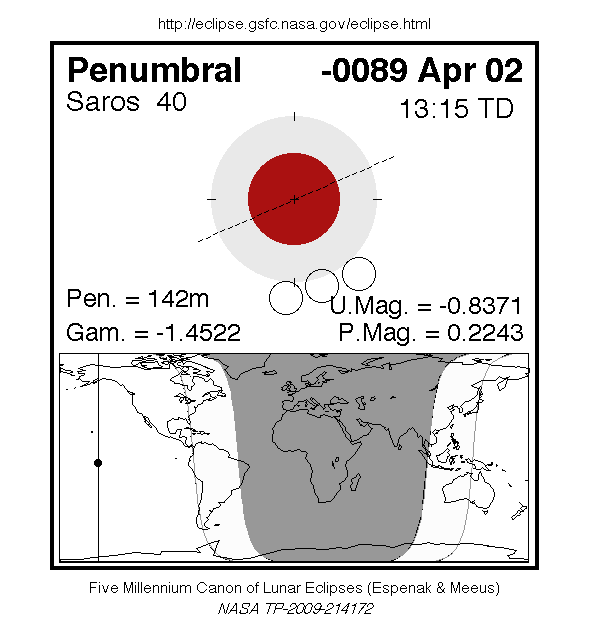A penumbral eclipse of the Moon occurred on 2 April, 0090 BC UT Old Style, with maximum eclipse at 10:04 UT. This very subtle penumbral eclipse was essentially invisible to the naked eye; though it lasted 2 hours and 22 minutes, just 22% of the Moon's disc was in partial shadow (with no part of it in complete shadow).
The penumbral eclipse lasted for 2 hours and 22 minutes.
Maximum eclipse was at 10:04:16 UT.
Overview Map
This map sourced from NASA Goddard Space flight Center: GSFC Eclipse Web SiteGSFC Eclipse Web Site
The primary source of all the information on eclipses presented here at Hermit Eclipse. (NASA Goddard Space flight Center)
shows the visibility of the eclipse. (Click on it for the
full-sized version.)
Eclipse Season and Saros Series
This eclipse season contains 3 eclipses:
This was the 72nd eclipse in lunar Saros series 40.The surrounding eclipses in this Saros series are:
This Saros series, lunar Saros series 40,
is linked to solar Saros series 47. The
nearest partner eclipses in that series are:
Eclipse Parameters
| UT Date/time (max) | 10:04:16 on 2 Apr UT |
TDT Date/time (max) | 13:15:17 on 2 Apr TDT |
| Saros Series | 40 |
Number in Series | 72 |
| Penumbral Magnitiude | 0.2243 |
Central Magnitiude | -0.8371 |
| Gamma | -1.4522 |
Path Width (km) | |
| Delta T | 3h11m |
Error | ± 9m31s (95%) |
| Penumbral Duration | 2h22m |
Partial Duration | |
| Total Duration | |
| |
| Partial Rating | |
Total Rating | |
Note that while all dates and times on this site (except
where noted) are in UT, which is within a second of civil time,
the dates and times shown in NASA's eclipse listingsGSFC Eclipse Web Site
The primary source of all the information on eclipses presented here at Hermit Eclipse. (NASA Goddard Space flight Center)
are in the TDT timescale.
Data last updated: 2015-06-21 22:11:42 UTC.

